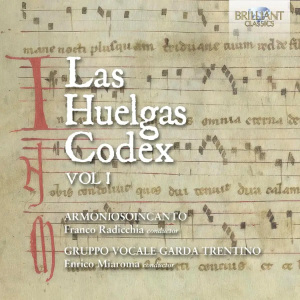
Las Huelgas Codex Volume 1
Armoniosoincanto/Franco Radicchia (CD1)
Gruppo Vocale Garda Trentino/Enrico Miaroma (CD2)
rec. 2023, Chiesa Abbaziale di San Secondo, Gubbio, Italy (CD1); Chiesa di Santa Maria al Lago, Italy (CD2)
Brilliant Classics 96619 [2 CDs: 117]
This is the first volume in an enterprising project, guided by Franco Radicchia, to record all the music in a 13th-century manuscript associated with the early 14th-century convent of Santa María la Real de Las Huelgas. The Codex was rediscovered in 1904 and published in the 1930s. (In 2009, I visited Santa Maria la Real de Huelgas, just a short walk out of the amazing city of Burgos. I hoped to view the manuscript and see the royal tombs. It was a memorable experience.) The manuscript was, it seems, ‘authorised’ by King Alfonso VIII of Castile (1155-1214) and his wife Eleanor, the daughter of Henry II of England and Eleanor of Aquitaine.
The pieces here are mostly monophonic, such as Eterni numinis, and performed generally in tempus perfectum. Several are in two parts, such as Ave gloriosa / Salve Virgo regia, and there is an occasional three-part work resulting in a polytextual motet, as in Salve porta regum gloriae / Salve salus gencium / Salve parens. Mass movements may be troped, for example the Kyrie fons bonitatis, when the text proper is chanted and the troped section sung to two-part organum.
A fascinating innovation on these discs is that two contrasting groups of singers are employed, all either female or treble voices.
The singers on the first disc are Armoniosoincanto, ten female voices who share the pieces between them. There are no instruments. The sound is clear, mature and – especially in the solo items – well focused. To me, the performances are rather careful and can lack flare and character. For example, Virgines egregie with its line ‘sing a song of joy to the Lord’ could be more joyous.
A younger choir appears on the second disc. Gruppo Vocale Garda Trentino consists of eleven teenage boys and girls. The conductor plays the portative organ in five of the tracks. It is particularly pleasing in the long Stabat juxta Christi crucem where it breaks up the verses. So, it not only helps the tuning in the longer pieces but add a pleasing texture. Again, the pieces are divided up between the young singers. They are very impressive and have even more clarity of pitch and articulation. Franco Radicchio’s booklet essay describes them as having ‘luminosity’. Both choirs are pictured within.
The performances offer no frills, so one might call them cerebral. I feel they have an air of authenticity suitable for such a monastic establishment. A major drawback for many will be the lack of texts; they also do not appear on the label’s website.
There is a different acoustic for each choir. Both are good, but there is excellent sound at the church at Torbole, on the edge of Lake Garda where the young choir is based.
This repertoire has been issued on disc earlier. The three recordings I have come from 20-30 years ago. If you can find them, they are worth hearing. Sequentia have a disc in the Vox Iberica series (DHM 05472 77238 2). Discantus and Brigitte Lesne made a recording for Opus 111 (OPS 30-68). Both are a capella. Then there is a colourful account on Signum entitled Temple of Chastity, sang by Mille Fleurs with percussion and harp (SIGCD 043). Thanks to these discs, I found some of the texts of these new recordings.
So, never mind caveats and reservations, I look forward to the next volume in this series. I wonder if two more contrasting choirs will be employed. Perhaps we might also be guided to the texts for downloading.
Gary Higginson
Help us financially by purchasing from



Contents
CD1
Kyrie, Rex virginum
Conditor Kyrie
Kyrie, fons bonitatis
Kyrie Eleison
Gloria in excelsis, Spiritus et alme
Benedicta et venerabilis, Virgo Dei genitrix
Iam nubes dissolvitur/Iam novum sydus oritur/Solem
Ave verum corpus/Ave, vera caro Christi
Ave gloriosa/Salve , Virgo regia mater
Celi solem imitantes
Confessorum agonia
Virgines egregie, virgins sacrae
Iocundare plebs fidelis
Salve porta regem gloriae/Salve salus gencium/Salve sancta parens
CD2
Verbum bonum et suave
Flavit auster flatu
Angelorum laude Digna
Eterni numinis
Salve sancta Christi parens
Eya Mater fidelium
In virgulto gratie
Stabat juxta Christi crucem
Promereris summe laudis
Nobis cedunt vetera
Maria, virgo virginum

















